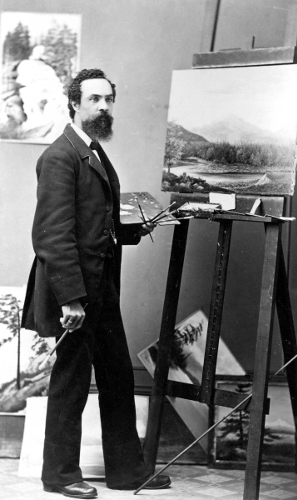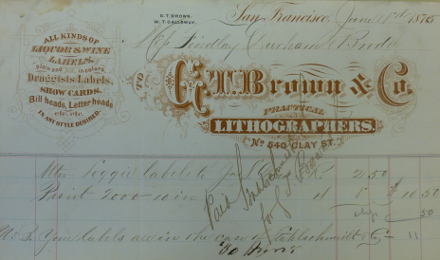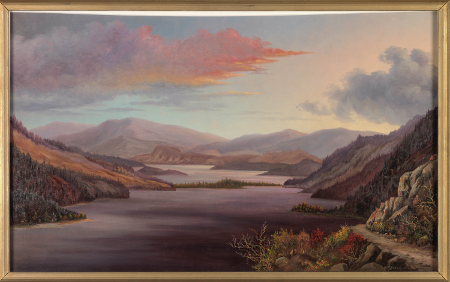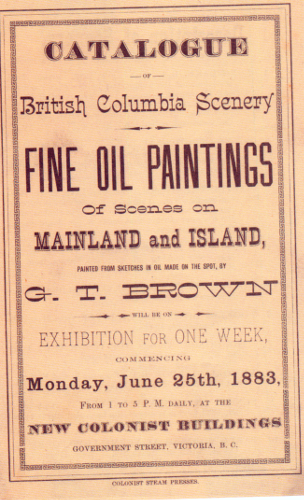The Missing British Columbia Paintings
- of -
Grafton Tyler Brown
Grafton Tyler Brown
By John Lutz
Grafton Tyler Brown became the first professional artist in the province when he reinvented himself in his move to British Columbia in 1882. Two years later he headed south to Tacoma and has since become famous in the United States as the first and one of the best Black professional artists in California and the Pacific Northwest. Practically unknown now, his paintings of the Fraser, Thompson, Okanagan, and Similkameen Valleys as well as southern Vancouver Island, were celebrated in Victoria in 1883 when he opened his inaugural exhibition. But Brown, the famous American Black artist, was, surprisingly, a White artist in British Columbia!
Brown was African American by birth. His parents, Thomas and Wilhelmina, were two free Blacks who had left the slave state of Maryland for the free state of Pennsylvania in 1837. Grafton Tyler Brown born February 22, 1841, was the first of three sons and a daughter, all of whom appear as Black in the censuses of the period.
 Grafton Tyler Brown in his Victoria studio, 1883, Image A-08775 courtesy of the Royal BC Museum, BC Archives.
Grafton Tyler Brown in his Victoria studio, 1883, Image A-08775 courtesy of the Royal BC Museum, BC Archives.
At age 17 he headed west for Sacramento, California, on his own, and worked over the next two years as a hotel steward and porter where the local census and directory makers described him as “Black” and “Colored.” There, his painting caught the attention of the local paper which reported In November 15, 1859 “We noticed last evening some very excellent painting done by Grafton T. Brown, a servant boy in the St. George Hotel….The lad has never taken lessons but his execution will compare favorably with that of acknowledged artists.”
In a move that changed his life, and, it would seem, his colour, in 1861, age 20, Brown left Sacramento for San Francisco where he was hired as an artist by a German printer Charles Conrad Kuchel. Brown was sent around the west to draw panoramic views of towns which Kuchel lithographed and sold to the townspeople, many of whom had also paid extra to have their homes and businesses prominently represented.
 Grafton Tyler Brown while a printer in San Francisco invoicing John Sulivan Deas for the first salmon can labels in BC. MS 1999 courtesy of the Royal BC Museum, BC Archives.
Grafton Tyler Brown while a printer in San Francisco invoicing John Sulivan Deas for the first salmon can labels in BC. MS 1999 courtesy of the Royal BC Museum, BC Archives.
Kuchel died in debt in 1864 and his widow turned over the business to Brown. At age 24, the former Black porter, owned an established print shop in San Francisco, and was one of only 55 lithographers in the entire United States.
But he was no longer entirely Black.
Whether by chance or more likely by craft, when Grafton Tyler Brown, who had inherited his father’s lighter colouring, was enumerated by the San Francisco directory makers for the 1861, he was listed without the designation “coloured” applied to Blacks. The 1870 census taker called him a “Mulatto” suggesting he was thought to have only one African American parent while that same year the Dun and Bradstreet credit agency called him a “quadroon” meaning that he was thought to have a single African American grandparent. In the census of 1880 he was listed as “White”. Race, the idea that people can be rigidly separated by their looks, proved itself to be quite arbitrary and open to interpretation.
Grafton T. Brown and Co took the lead in colour printing on the Pacific Coast and when in 1870, the first salmon canner in British Columbia, John Sullivan Deas, himself a Black entrepreneur, needed colourful labels, he turned to Brown, whom he likely knew from when both lived near each other in San Francisco.
In 1882 Brown moved again and reinvented himself one more time. Now generally accepted as “White” he decided to make a living as a painter, selling original landscape paintings and he chose to do this reinvention in Victoria, British Columbia.
To see the little known parts of the province, he joined a geological survey party in 1882 as they travelled from Kamloops, through the Okanagan valley, up the Similkameen, and back to the Fraser by late October. By November he had established himself in a studio in Victoria in the Occidental Hotel at the corner of Wharf and Johnson Streets and the British Colonist newspaper directed clients to him, describing him as “an artist of more than local celebrity in California and elsewhere.”
 Long Lake, looking down the lake from the wagon road between Spallumcheen and Okanagan Valleys. Sketched October 9, 1882. Image PDP00119 courtesy of the Royal BC Museum, BC Archives.
Long Lake, looking down the lake from the wagon road between Spallumcheen and Okanagan Valleys. Sketched October 9, 1882. Image PDP00119 courtesy of the Royal BC Museum, BC Archives.
The paper told Victorians that Brown was proposing to turn the sketches from his British Columbia trip into paintings “and will furnish any of them to order that visitors may take a fancy to.” He did a commission for George Deans and drew a ink sketch of his farm which is in the BC Archives.
By June 1883 Brown had converted his sketches along with views of Victoria into oil paintings and arranged to open his first art show. The British Colonist described and promoted the work:
Yesterday was the opening day of the exhibition at The Colonist's new building of oil paintings from the brush of our local artist, Mr. G. T. Brown. Viewed in the light of artistic productions they were excellent, but when inspected by those with whom the scenes represented were familiar, their fidelity elicited an extra meed of praise...
A reviewer described Grafton as “the pioneer of this intellectual and refined art” and “the first to supply the young people of this city with the grand ideas of the ‘noble art’” of landscape painting. The catalogue that accompanied the show listed 22 paintings including the areas traversed by Brown the previous summer and several of the Gorge, Esquimalt and Victoria Harbours, and Mount Baker.
 Catalogue cover from Robert J. Chandler, San Francisco Lithographer: African American Artist Grafton Tyler Brown, (Norman: University of Oklahoma, 2014) p. 162.
Catalogue cover from Robert J. Chandler, San Francisco Lithographer: African American Artist Grafton Tyler Brown, (Norman: University of Oklahoma, 2014) p. 162.
By August 1884 Brown had shifted across the straits and made Tacoma his base and mountains his specialty advertising that he offered “views of Mt. Tacoma, Mt. Hood, Mt. Baker, Mt. Adams and others. Scenes on the Columbia River and Puget Sound on hand and painted to order.” By spring 1885 Brown had moved to Portland where he helped create the Portland Art Club which brought together the best amateur and professional artists in the city. The regular interaction with fellow artists changed his paintings which began to incorporate more abstract elements.
In 1889, Brown moved again to Helena, Montana, the gateway to Yellowstone where he sold his mountain and geyser paintings, largely to the tourist market. The itinerant painter, who had been single his whole life was joined in Helena by Albertine Espey, a French born woman, 20 years his junior, recently widowed.
Brown gave up art in 1892, for reasons unknown, and together the pair moved to St. Paul, Minnesota, where he worked as a draftsman for the US Army Corp of Engineers and the City of St Paul. He retired in 1916 and died March 2nd 1918. His death certificate listed him as White.
Over his 75 years, Brown had gone from obscurity and poverty to relative fame as an artist. A price list from the 1880s shows his paintings selling from $35 to $350. Today his work fetches prices up to $75,000. He had come from a poor family in Pennsylvania, travelled extensively through the Canadian and American west and settled in the headwaters of the Mississippi. In the process, he had also changed his race from Black to White, a transition helped by his remarkable talents and an artistic career that he launched with British Columbia scenery in Victoria in 1883.
This text about Grafton Tyler Brown originally appeared in the Islander supplement to the Victoria Times Colonist, February 8, 2015 pages D5-6.
Sources:
- The main source for the life and work of G.T. Brown is Robert J. Chandler, San Francisco Lithographer: African American Artist Grafton Tyler Brown. Norman: University of Oklahoma, 2014.
- Other sources include:
- B.C. Archives.
- British Colonist Newspaper, 1882-1884.
- Directories for San Francisco and Victoria, 1860-1884.
- Humpal, Mark. “Edward Espey and Grafton Tyler Brown,” http://www.markhumpal.com/essays.html
- Ireland, Willard. “G.T. Brown Artist”. Okanagan Historical Society Report. 1948. 166-170.
- LeFalle-Collins, Lizetta. “Grafton Tyler Brown: Selling the Promise of the West,” International Review of African American Art, 12, No. 1,(1995) 26-44.
- Patterson, T.W. “Grafton Tyler Brown, Black Artist of the West,” Canada West Magazine. Volume 8, Number 2 (Spring, Summer, & Fall 1978) 31-33.
- Reps, John W. Panoramas of Promised: Pacific Northwest Towns and Cities on Nineteenth Century Lithographs. Pullman: Washington State University Press, 1984.
